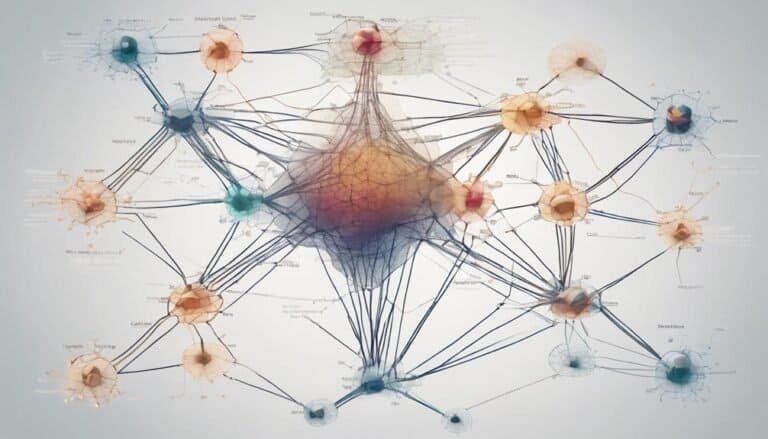AI for Sustainable Living: The Essential Guide
Curious about how AI can transform the way we live sustainably?
From optimizing energy consumption to revolutionizing waste management, the applications of artificial intelligence in fostering a greener future are vast and impactful.
As you explore the intricate synergy between cutting-edge technology and environmental conservation, get ready to uncover actionable insights and innovative solutions that can reshape the way we approach sustainability challenges.
Key Takeaways
- AI optimizes resource management and energy efficiency for sustainable living.
- Energy audits and data analytics drive informed decisions for sustainability.
- Recycling, composting, and AI-enhanced waste management reduce environmental impact.
- Data-driven urban planning and green infrastructure promote sustainable cities.
The Role of AI in Sustainability
Utilizing artificial intelligence (AI) is crucial in achieving sustainability goals across various industries and sectors. AI plays a significant role in addressing environmental impact by optimizing resource management, reducing waste, and enhancing energy efficiency. Through AI-powered data analytics, industries can identify patterns and trends to make informed decisions that minimize their ecological footprint. By automating processes and predicting outcomes, AI enables businesses to operate more sustainably while maximizing productivity.
Moreover, ethical considerations are paramount when integrating AI into sustainability practices. Ensuring transparency, accountability, and fairness in AI algorithms is essential to prevent bias and uphold ethical standards. Ethical AI frameworks help in maintaining trust with stakeholders and safeguarding against unintended consequences that may arise from AI implementation. By prioritizing ethical considerations, organizations can navigate the complexities of AI in sustainability with integrity and responsibility. Ultimately, the synergy between AI technology and sustainability efforts holds the potential to drive positive environmental change while upholding ethical values.
Energy Efficiency Solutions
To enhance sustainability efforts in various industries and sectors, implementing energy efficiency solutions is crucial for reducing environmental impact and optimizing resource consumption. Building automation plays a significant role in enhancing energy efficiency by utilizing smart technologies to control heating, ventilation, air conditioning systems, lighting, and other building functions. These systems can adjust settings based on occupancy patterns, external conditions, and energy demand, leading to substantial energy savings.
Energy audits are another essential aspect of energy efficiency solutions. Conducting regular energy audits helps identify areas of energy wastage and inefficiency within buildings or industrial processes. By analyzing energy usage patterns and identifying opportunities for improvement, organizations can implement targeted strategies to optimize energy consumption.
Incorporating building automation technologies and conducting thorough energy audits are key steps towards achieving sustainable energy efficiency in various sectors. By leveraging these solutions, businesses can't only reduce their environmental footprint but also realize cost savings and contribute to a more sustainable future.
Waste Reduction and Management
Implementing efficient waste reduction and management practices is crucial for promoting sustainability and minimizing environmental impact across various industries and sectors. Recycling initiatives play a significant role in reducing the amount of waste sent to landfills. By sorting and recycling materials like paper, plastic, glass, and metal, businesses can decrease their carbon footprint and conserve valuable resources. Composting programs are another essential aspect of waste management, allowing organic waste to be transformed into nutrient-rich compost for agricultural use.
AI technologies can enhance waste reduction efforts by optimizing waste collection routes, predicting waste generation patterns, and identifying opportunities for recycling and composting. Machine learning algorithms can analyze vast amounts of data to identify trends and patterns that humans may overlook, leading to more effective waste management strategies. Additionally, AI-powered sorting systems can improve recycling efficiency by automatically separating different types of materials. By integrating AI with recycling initiatives and composting programs, businesses can achieve higher levels of sustainability and contribute to a cleaner, greener future.
Sustainable Agriculture Practices
Efficient waste reduction and management practices in industries like agriculture are essential for promoting sustainability, and one key area that plays a crucial role in this regard is Sustainable Agriculture Practices. Sustainable Agriculture Practices focus on methods that maintain soil health and promote long-term crop productivity. Two fundamental elements of sustainable agriculture are soil health and crop rotation.
| Soil Health | Crop Rotation |
|---|---|
| Improves fertility | Enhances soil structure |
| Reduces erosion | Minimizes pest outbreaks |
| Increases water retention | Boosts crop yield |
Maintaining soil health through sustainable practices like cover cropping and reduced tillage helps preserve essential nutrients and microbial biodiversity. Crop rotation, the practice of planting different crops in a sequential series on the same field, helps break pest cycles and improve soil fertility naturally. By implementing these sustainable agriculture practices, farmers can ensure the long-term viability of their land while promoting environmental conservation and food security.
Smart Urban Planning Initiatives
Smart urban planning initiatives leverage data-driven strategies to optimize city infrastructure and enhance sustainability for future generations. By integrating AI technologies into urban development processes, cities can create more efficient transportation systems, reduce energy consumption, and promote the use of green infrastructure. Green infrastructure, such as green roofs, rain gardens, and permeable pavements, plays a crucial role in mitigating urban heat islands, managing stormwater runoff, and enhancing biodiversity within urban areas.
AI in urban planning also enables the development of smart buildings that use energy more efficiently, reducing overall carbon footprints. Through predictive analytics, cities can anticipate future growth patterns and plan infrastructure accordingly, optimizing land use and reducing environmental impact. Additionally, AI can help in designing more walkable neighborhoods, promoting active transportation, and improving public health outcomes.
AI in Water Conservation
You can explore how AI is revolutionizing water conservation through the implementation of smart irrigation systems. These systems utilize real-time data to optimize water usage for agriculture and landscaping, reducing waste and promoting sustainability.
Additionally, AI-driven leak detection technology can identify and address water leaks promptly, preventing significant water losses and supporting efficient water management practices.
Smart Irrigation Systems
Utilizing artificial intelligence technology, irrigation systems have transformed into sophisticated tools for optimizing water usage in agricultural settings. Smart irrigation systems leverage AI algorithms to monitor soil moisture levels continuously. By analyzing data on factors like weather forecasts, plant type, and evapotranspiration rates, these systems can precisely determine the irrigation needs of crops.
Maintaining optimal soil moisture not only conserves water but also enhances crop yield. AI in smart irrigation helps prevent overwatering or underwatering, which are common issues in traditional irrigation methods. By delivering the right amount of water at the right time to each plant, smart irrigation systems contribute significantly to sustainable water management practices in agriculture, ensuring efficient resource utilization and improved productivity.
Leak Detection Technology
With the advancement of artificial intelligence technology, leak detection systems have revolutionized water conservation efforts through their precision and efficiency in identifying and addressing water leaks. These systems utilize AI algorithms to analyze water flow data and detect anomalies, allowing for early intervention and reduced water waste.
- Remote Monitoring: AI-powered leak detection technology enables real-time monitoring of water systems, providing instant notifications of any leaks or irregularities.
- Asset Protection: By swiftly identifying and repairing leaks, these systems help protect valuable assets such as infrastructure and prevent costly damages.
- Efficient Resource Management: The precise detection capabilities of AI in leak detection technology aid in optimizing water usage and promoting sustainable practices for a greener future.
Biodiversity Preservation Strategies
Implementing habitat restoration projects is a key strategy in biodiversity preservation efforts. Ecosystem restoration plays a crucial role in maintaining healthy populations of various species and ensuring the balance of ecosystems. Wildlife protection initiatives are also vital to safeguarding vulnerable species from extinction. Conservation technology, such as AI-powered monitoring systems, can aid in tracking and protecting wildlife more effectively. Habitat preservation is essential to providing safe spaces for diverse organisms to thrive. By conserving natural habitats, we can protect the intricate web of life on Earth. Now, let's delve into a table that outlines some common biodiversity preservation strategies:
| Biodiversity Preservation Strategies | Description | Benefits |
|---|---|---|
| Ecosystem Restoration | Reintroduction of native species and removal of invasive species to restore ecological balance | Enhances biodiversity and ecosystem services |
| Wildlife Protection | Implementing measures to prevent poaching and illegal wildlife trade | Preserves species diversity and ecosystem resilience |
| Conservation Technology | Utilizing AI and remote sensing for monitoring and managing wildlife populations | Improves efficiency and accuracy in conservation efforts |
Climate Change Mitigation Measures
You can begin by exploring the role of renewable energy sources in reducing greenhouse gas emissions and combating climate change.
Investigate methods for lowering carbon footprints across industries and households to limit environmental impact.
Additionally, consider how sustainable transportation options, such as electric vehicles and improved public transit systems, contribute to mitigating climate change effects.
Renewable Energy Sources
Renewable energy sources play a crucial role in mitigating climate change by reducing greenhouse gas emissions and promoting sustainable living practices.
Solar power harnesses the sun's energy through photovoltaic cells, converting sunlight into electricity efficiently.
Wind turbines utilize the kinetic energy of the wind to generate clean power, with advancements in technology making them more cost-effective and environmentally friendly.
Additionally, geothermal energy taps into the Earth's heat to produce electricity and heat water sustainably.
These renewable energy sources not only help combat climate change but also offer long-term benefits by reducing dependence on fossil fuels and contributing to a cleaner, greener future for all.
Carbon Footprint Reduction
Reducing your carbon footprint is a critical step in mitigating climate change and promoting sustainability practices. Making lifestyle changes and sustainable choices can significantly impact your environmental footprint. Engaging with your community to raise awareness about carbon footprint reduction can amplify the positive environmental impact. By reducing energy consumption, recycling, and choosing sustainable products, you contribute to a greener future. Small actions, like using energy-efficient appliances or opting for public transportation, can make a big difference. Community engagement plays a vital role in spreading awareness and encouraging others to adopt eco-friendly practices. Together, these efforts can help combat climate change and create a more sustainable world.
| Action | Impact |
|---|---|
| Lifestyle changes | Reduce emissions |
| Sustainable choices | Lower environmental impact |
| Community engagement | Spread awareness |
| Energy consumption | Decrease carbon footprint |
| Recycling | Promote circular economy |
Sustainable Transportation Options
Sustainable transportation options play a crucial role in mitigating climate change by reducing greenhouse gas emissions and promoting eco-friendly mobility solutions. When considering sustainable transportation, electric vehicles and public transit are key components that significantly contribute to a greener environment:
- Electric Vehicles: By transitioning to electric vehicles, you can help decrease reliance on fossil fuels, leading to lower emissions and improved air quality.
- Public Transit: Opting for public transportation not only reduces individual carbon footprints but also helps alleviate traffic congestion and decrease overall emissions from multiple commuters sharing a ride.
- Carpooling: Sharing rides through carpooling initiatives can further reduce the number of vehicles on the road, cutting down emissions and promoting a more efficient use of transportation resources.
Conclusion
You've now uncovered the power of AI in driving sustainable living practices. Imagine a world where energy is optimized, waste is minimized, and agriculture is sustainable.
Picture smart cities where water is conserved, biodiversity is protected, and climate change is tackled head on.
With AI at the forefront, these visions aren't just dreams, but achievable realities. Embrace the potential of AI for a brighter, greener future for all.







